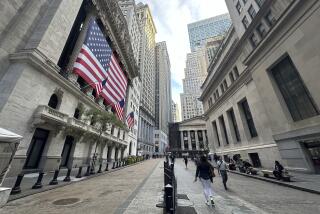Prepare for Rates to Jump or Tumble
It’s decision time for the bond market: Either interest rates are going up sharply, or they’re about to tumble. And the woozy stock market is likely to be pulled along with bonds.
That’s the widespread feeling on Wall Street as financial markets brace for an onslaught of economic data between now and Friday, including the government’s estimate of second-quarter gross domestic product, a key report on manufacturing activity, and July job-growth data.
In recent speeches, Federal Reserve Board Chairman Alan Greenspan appeared to make clear--as clear as he makes any point for public consumption--that the data this week would largely determine whether the Fed feels obliged to tighten credit for the first time since early 1995.
The Fed doesn’t meet until Aug. 20, but the bond market isn’t likely to wait for the central bank to convene. If this week’s economic signals point to a further acceleration in activity--and upward pressure on inflation--many analysts see bond yields quickly climbing higher, after two months of shuffling in a fairly narrow range.
But if the economic data provide enough of a sense that the economy is slowing from the heated pace of spring, bond investors may quickly assume that the Fed won’t be compelled to raise short-term interest rates (the classic credit-tightening move). And that in turn could allow bond yields, mortgage rates and other long-term interest rates to fall back rapidly.
Fast moves in the bond market have been the rule in recent years: Rates have rarely sat still for long, and the market has tended to overreact on the upside and the downside.
Either way, the recently pummeled stock market probably will be a hostage to the bond market’s moves. With growing worries about the strength of corporate earnings looking into 1997, interest rates have again become a key determinant of stock prices.
With so much at stake, economists have been forced to take positions in recent weeks, either telling clients to prepare for a jump in rates or prepare for a tumble. And surprised all year by the economy’s strength, many analysts are warning that this week’s data will probably point to more of the same--forcing the Fed to boost its benchmark short-term interest rate, the federal funds rate, from the current 5.25% to 5.50% or even 5.75%.
“While the markets need evidence of economic slowdown and reduced wage pressures, that evidence is unlikely to materialize this week,” economist Donald Straszheim of Merrill Lynch told clients in a memo on Monday.
John Williams, economist at Bankers Trust in New York, said he believes many investors aren’t prepared for what he considers to be a strong probability of a Fed rate increase on or before Aug. 20. “I think the complacency [in the markets] is going to be splintered” by this week’s data, he said.
Yet the first piece of evidence, the government’s report Tuesday on second-quarter labor costs, sparked a mild rally in bonds. The 10-year Treasury note yield, a good proxy for mortgage and other such rates, fell to 6.88% Tuesday from 6.93% Monday.
Analysts said the report was mixed, showing increasing upward pressure on private-industry wages but overall modest growth in labor costs.
Greenspan has warned that he would consider strong growth in labor costs to be inflationary, forcing the Fed to boost interest rates in an attempt to keep the economy from overheating.
*
The labor report notwithstanding, Williams and many other economists expect the second-quarter GDP report and the manufacturing-sector report on July activity, both due Thursday, and the Friday report on July job growth, to present the Fed with a picture of an economy that needs to be reined-in with higher short-term interest rates.
And if that’s the case, longer-term bond yields will jump as well, Williams argues. Despite the sharp rise in bond yields already this year, history shows that the bond market usually reacts badly to the first Fed tightening move.
Why? Because investors assume that once the Fed begins to tighten, it will continue to do so until it’s sure the economy is slowing. After one Fed move, “the market begins discounting the next move,” said Philip Braverman, economist at DKB Securities in New York.
That was the vicious cycle of 1994: Nearly every Fed boost in short rates led to higher bond yields, as investors continually bet on more to come.
But Lehman Bros. economist Stephen Slifer notes an important difference between 1994 and today: The Fed was boosting short-term rates from a much lower level--3% compared with 5.25% today. In theory, that should mean that Greenspan & Co. don’t have to tighten as much to get the desired effect in the economy.
Even so, Slifer thinks the yield on the bellwether 30-year Treasury bond, 7.03% Tuesday, could quickly leap to 7.25% if this week’s economic data are as robust as he expects. Williams thinks the T-bond yield could soon reach 7.50%--a level that could slam the already-weakened stock market.
But what if the data suggest the Fed doesn’t have to tighten credit at all? Economist David Jones of Aubrey Lanston & Co. says the T-bond yield could rapidly fall back to 6.75% in a “relief” rally. That could, naturally, help revive the stock market as well.
Insider Selling Abates: Corporate insiders, who were dumping their own companies’ shares at a record pace in the spring as prices soared, have slowed that selling considerably in recent weeks as the market has tumbled, insider-trackers report.
CDA Investnet/Insiders’ Chronicle newsletter says the ratio of insiders’ open-market transaction sales to buys has slid from 4.2 to 1 in late June to 1.8 to 1 in the week ended Sunday. The transactions are tracked by insiders’ required filings with the Securities and Exchange Commission. Bob Gabele, editor of the newsletter, said the abatement of selling is a good sign, suggesting that insiders don’t want to let go of shares at current depressed prices. But Gabele also said there isn’t yet any sign of heavy insider buying--the signal that would indicate insiders see current share prices as bargains.
(BEGIN TEXT OF INFOBOX / INFOGRAPHIC)
Ready to Bust Out
The yield on 10- year Treasury notes- a good indicator of long- term rates on mortage and other consumer loans- has been stuck in a fairly narrow range since mid- May. But many analysts think rates are primed either to surge or tumble, depending on economic data due later this week. Indeed, as the past three years show, the rate rarely stays the same. Ten- year Treasury note yield, month- end data and latest:
Sept. ‘93: 5.38%
Nov. ‘94: 7.91%
Dec. ‘95: 5.57%
Tuesday: 6.88%
Source: Bloomberg Business News
(BEGIN TEXT OF INFOBOX / INFOGRAPHIC)
Insider Selling Ebbs
Selling of stock by corporate insiders- execuetives and directors- has sharply abated in recent weeks as the market has slumped. The weekly ratio of insider sales to buys based on the transactions reported to the Securities and Exchange Commission:
7/28: 1.8
Source: CDA / Investment Insiders Chronicle
* WAGE REPORT: New data indicate modest gains. D2
More to Read
Inside the business of entertainment
The Wide Shot brings you news, analysis and insights on everything from streaming wars to production — and what it all means for the future.
You may occasionally receive promotional content from the Los Angeles Times.










